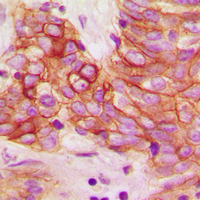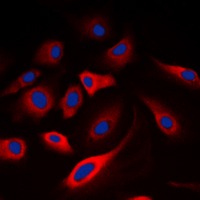Description:Rabbit polyclonal antibody to Calmodulin (Phospho-T80/S82)Immunogen:KLH-conjugated synthetic phosphopeptide corresponding to residues surrounding T80/S82 of human Calmodulin protein. The exact sequence is proprietary.Purification:The antibody was purified by immunogen affinity chromatography.Clonality:PolyclonalForm:Liquid in 0.42% Potassium phosphate, 0.87% Sodium chloride, pH 7.3, 30% glycerol, and 0.01% sodium azide.Dilution:WB (1/500 - 1/1000), IH (1/100 - 1/200), IF/IC (1/100 - 1/500)Gene Symbol:CALM1Alternative Names:CALM; CAM; CAM1; CAM2; CAMB; CALML2; CAM3; CAMC; CAMIII; Calmodulin; CaM
Entrez Gene (Human):
801;
805;
808;
Entrez Gene (Mouse):
12313;
12314;
12315;
Entrez Gene (Rat):
24242;
24244;
50663;
SwissProt (Human):
P62158;
SwissProt (Mouse):
P62204;
SwissProt (Rat):
P62161;
Storage/Stability:Shipped at 4°C. Upon delivery aliquot and store at -20°C for one year. Avoid freeze/thaw cycles.
-
 Western blot analysis of Calmodulin (Phospho-T80/S82) expression in MCF7 TNF-treated (A), NIH3T3 TNF-treated (B) whole cell lysates. (Predicted band size: 16 kD; Observed band size: 17 kD)
Western blot analysis of Calmodulin (Phospho-T80/S82) expression in MCF7 TNF-treated (A), NIH3T3 TNF-treated (B) whole cell lysates. (Predicted band size: 16 kD; Observed band size: 17 kD) -
 Immunohistochemical analysis of Calmodulin (Phospho-T80/S82) staining in human breast cancer formalin fixed paraffin embedded tissue section. The section was pre-treated using heat mediated antigen retrieval with sodium citrate buffer (pH 6.0). The section was then incubated with the antibody at room temperature and detected using an HRP conjugated compact polymer system. DAB was used as the chromogen. The section was then counterstained with haematoxylin and mounted with DPX.
Immunohistochemical analysis of Calmodulin (Phospho-T80/S82) staining in human breast cancer formalin fixed paraffin embedded tissue section. The section was pre-treated using heat mediated antigen retrieval with sodium citrate buffer (pH 6.0). The section was then incubated with the antibody at room temperature and detected using an HRP conjugated compact polymer system. DAB was used as the chromogen. The section was then counterstained with haematoxylin and mounted with DPX. -
 Immunofluorescent analysis of Calmodulin (Phospho-T80/S82) staining in A549 cells. Formalin-fixed cells were permeabilized with 0.1% Triton X-100 in TBS for 5-10 minutes and blocked with 3% BSA-PBS for 30 minutes at room temperature. Cells were probed with the primary antibody in 3% BSA-PBS and incubated overnight at 4 °C in a hidified chamber. Cells were washed with PBST and incubated with a DyLight 594-conjugated secondary antibody (red) in PBS at room temperature in the dark. DAPI was used to stain the cell nuclei (blue).
Immunofluorescent analysis of Calmodulin (Phospho-T80/S82) staining in A549 cells. Formalin-fixed cells were permeabilized with 0.1% Triton X-100 in TBS for 5-10 minutes and blocked with 3% BSA-PBS for 30 minutes at room temperature. Cells were probed with the primary antibody in 3% BSA-PBS and incubated overnight at 4 °C in a hidified chamber. Cells were washed with PBST and incubated with a DyLight 594-conjugated secondary antibody (red) in PBS at room temperature in the dark. DAPI was used to stain the cell nuclei (blue).
Phytoestrogens induce apoptosis via extrinsic pathway, inhibiting nuclear factor-kappaB signaling in HER2-overexpressing breast cancer cells


 Datasheet
Datasheet MSDS
MSDS